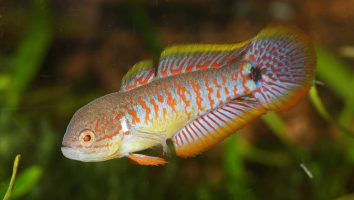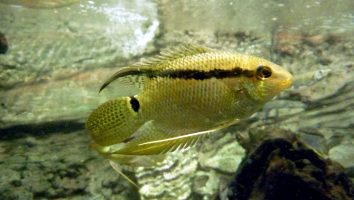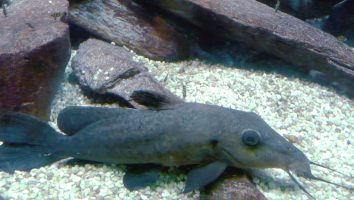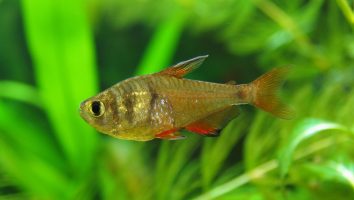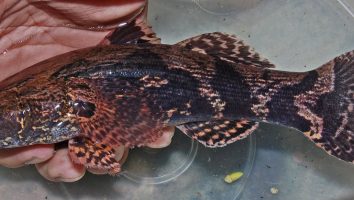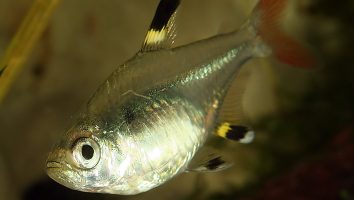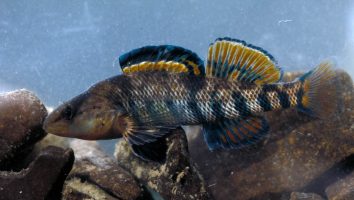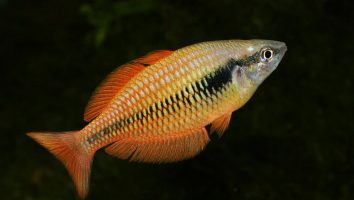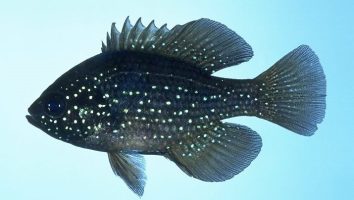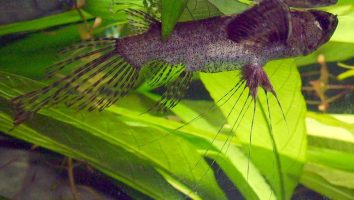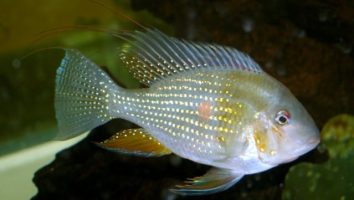The snakeskin barb is a freshwater fish that is native to Southeast Asia. They are a peaceful fish that make a great addition to any community tank.
The snakeskin barb is a silver color with black stripes that run horizontally down their body. The stripes on their body give them a snakeskin like appearance, hence their name.
Snakeskin barbs are a schooling fish, so they should be kept in groups of at least 6. They are relatively easy to care for and make a great beginner fish.
Table of contents
Species overview
The snakeskin barb (scientific name: Barbonymus schwanenfeldii) is a freshwater fish that’s native to the Malay Peninsula, Thailand, and Indonesia.
They prefer slow-moving waters with plenty of vegetation, which is something that’s common to many species of barb.
Snakeskin barbs are a popular choice for aquariums because of their unique coloration. As their name suggests, they have a pattern on their body that resembles snakeskin.
These fish are also known to be quite hardy, which means they can adapt to a wide range of water conditions. This makes them a good choice for beginner aquarium owners.
Appearance

As you can probably guess from their name, the most notable feature on these fish is the snakeskin pattern that covers their bodies.
This pattern is made up of dark vertical lines that run the length of the fish. These lines are usually black or very dark brown. In between these lines, you’ll find a lighter color. This can be anything from tan to gold.
The background color of these fish can also be different. It’s not uncommon to see Snakeskin Barbs that are mostly brown, black, or gold.
This pattern is really only visible when you look at these fish from above. When you view them from the side, they just look like a dark solid color.
Snakeskin Barbs have a long and thin body shape that’s similar to a lot of other barbs. They have a moderate sized dorsal fin that starts about halfway back on their body.
This fin is triangular in shape and curves back towards their tail. Their anal fin is a bit shorter and also triangular. Both of these fins have a dark border.
The caudal fin on these fish is forked and slightly asymmetrical. It’s a bit taller than it is wide and tapers off towards the end.
Lifespan
The average lifespan of a snakeskin barb is around 5 to 8 years. However, some snakeskin barbs have been known to live up to 10 years in captivity.
As with any fish, the lifespan of a snakeskin barb can be impacted by a number of factors. Poor water quality, for example, can lead to a shortened lifespan.
Stress is also a big factor. If these fish are constantly being harassed by tank mates or if they don’t have enough hiding places, they can die prematurely.
Size
The average Snakeskin barb size is about 3-4 inches in length. However, some specimens have been known to reach 6 inches in length. These fish are relatively slender, so they don’t require a lot of space in your aquarium.
Tank
Tank Size
The recommended tank size for a single snakeskin barb is 30 gallons. If you want to keep more than one fish, you should add at least 15 gallons for each additional fish. These fish are schooling fish so they do best when they’re kept in groups.
We recommend a larger tank if you can provide it. These fish are very active and will appreciate the extra space to swim around.
Water Parameters
The snakeskin barb is a freshwater fish that’s native to the Malay peninsula. In the wild, they prefer slow-moving rivers and streams with lots of vegetation.
This is a hardy fish that can adapt to a wide range of water conditions. That said, it’s always best to try and mimic their natural habitat as closely as possible.
Here are some basic water parameters to help get you started.
- Water temperature: 72 to 82 degrees Fahrenheit
- pH levels: 6.0 to 7.5
- Water hardness: 5 to 15 dGH
- Alkalinity Levels: 2-12 dKH
What To Put In Their Tank
As with most fish, the interior of their tank is just as important as the exterior.
The first thing you need to take into account is the fact that these fish like to swim in open areas. That means you need to have plenty of space for them to move around.
We recommend a minimum tank size of 50 gallons, but the bigger the better.
The second thing to consider is the substrate. These fish love to dig, so you need something that won’t hurt them when they do.
We recommend a soft, sandy substrate for this species. This will be much easier on their barbels and give them a place to dig to their heart’s content.
As for decorations, it’s pretty much up to you. These fish don’t need anything specific, so feel free to get creative.
We recommend adding some plants, driftwood, and rocks to their tank. This will help create some hiding spots and make the inside of their habitat look a little more natural.
Common Diseases
The snakeskin barb is a very hardy fish that is resistant to most diseases. However, there are a few that you should be aware of.
The most common disease that these fish get is ich. This is a very contagious disease that is caused by a parasite. It’s the most common freshwater fish disease and it’s very easy to spot.
The symptoms are white spots on the body, fins, and gills of your fish. If you notice this, you need to act fast.
There are plenty of ich treatments available, but the sooner you start the treatment the better.
Another disease to be aware of is hole-in-the-head disease. This is a disease that is caused by poor water quality. It presents itself as pits or holes in the head of your fish.
If you notice this, the first thing you need to do is improve the water quality in your tank. This disease is easily curable if you catch it early, but it can be fatal if left untreated.
The best way to prevent these diseases is to maintain a clean and healthy environment for your fish. A well-maintained tank with good water quality is the best defense against disease.
Behavior & Temperament
Snakeskin barbs are beautiful, peaceful fish that make a great addition to any community tank. They’re relatively small, so they don’t need a lot of space to swim.
These fish are shy by nature and prefer to stay in groups. If you’re keeping them in a tank with other fish, make sure there are plenty of hiding places. That way, they can feel secure and won’t be as stressed.
When it comes to food, Snakeskin barbs are not picky eaters. They’ll pretty much eat anything you give them. However, they prefer live and frozen foods. So, if you can, try to incorporate those into their diet.
All in all, these are peaceful fish that are easy to care for. As long as you provide them with the right environment, they’ll thrive in your tank.
Tank Mates
The snakeskin barb is a peaceful, community-oriented fish. It does well in groups and can be kept with a wide variety of tank mates.
Because these fish are so adaptable, they can be difficult to pair with other fish. The best approach is to start with species that have similar water requirements.
From there, you can branch out and try different fish to see what works best. Some compatible snakeskin barb tank mates include:
- Neon Tetra
- Guppy
- Platy
- Molly
- Swordtail
- Corydoras
- Black Widow Tetra
- Harlequin Rasbora
- Leopard Danio
Breeding
Breeding the snakeskin barb is pretty easy as long as you follow a few simple steps. These fish are known to be good parents, so they will take care of everything once the eggs are laid.
First, you need to identify the males and females. The easiest way to do that is by looking at their fins. Males have longer and more colorful fins than females.
Once you’ve identified the sexes, you can start to set up a breeding tank. It should hold at least 20 gallons of water. The water temperature should be between 77 and 86 degrees Fahrenheit.
You don’t need to make too many changes to the water. Just make sure the quality is good and the pH is between 6.5 and 7.5.
Then, add some hiding places and plants. The plants are important because that’s where the female will lay her eggs. She’ll lay them on the leaves, and the male will fertilize them.
After the eggs are laid, the male will guard them. He’ll also fan them with his fins to keep them oxygenated.
The eggs will hatch in about five days. At that point, you can remove the adults and start feeding the fry baby brine shrimp.
Conclusion
The Snakeskin Barb is a great fish for beginner aquarists. They’re relatively easy to care for and are very peaceful, making them a great addition to community tanks.
They’re also very active fish, so they’ll add some life and excitement to your tank.
Overall, we think the Snakeskin Barb is a great choice for beginner aquarists and experienced fishkeepers alike.

